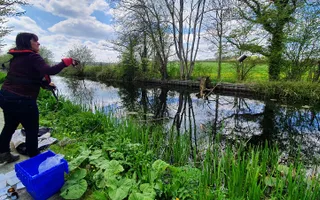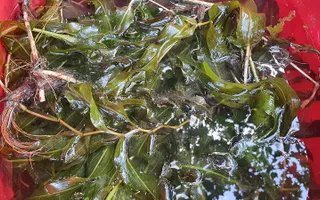Read this page in Welsh / Darllenwch y dudalen hon yn Gymraeg
Understanding the current condition of the canal
Whilst the Montgomery Canal may boast some wonderful wildlife, much of the canal is in a condition that does not support the reasons for its designation

Each spring sees a new surge of vegetation that dominates the channel and overshadows the water. With the arrival of autumn, these die back, leaving behind another layer of decaying material that adds to the layer of nutrient rich humus in which the next year's growth can establish.
Without management, the canal will continue to decline in this fashion, dominated by certain species, and reducing the biodiversity of the area.
Baselining
To develop a plan, you first need to know where you are starting from. This applies to the ecology of the Montgomery Canal and the surrounding areas. For this reason, a botanical survey of the entire length of the Montgomery Canal was carried out in 2022. This has given us an idea of the ecological state of the plant species that the canal is known and designated for.
When compared to historic data from surveys of the Montgomery Canal, it is possible to build up a picture of how the canal has changed over the decades, also reviewing the drivers behind this change.
Protected Species Surveys
Ahead of all works, whether they be dredging, nature reserve or bridge construction, surveys of the area are conducted for the following species (where suitable habitat is found):
- Badgers
- Bats
- Great Crested Newts
- Water Voles
- Otters
- Amphibians
- Reptiles
- Nesting Birds
- Hazel Dormouse
The area is also surveyed for the habitats that are present (Phase 1 Habitat Survey), checking to see if there are any priority habitats.
Wherever these species are identified as present, or potentially present, then further survey efforts are employed. The outcome of all of these surveys, is a site-by-site specific approach to ensure that we can design around the species where possible. If designing around species is not possible, then appropriate mitigation measures are employed to protect the species during works. As a last resort,
if the works could not be changed in design, or mitigation provided during works, then alternative habitat would be created, and species translocation carried out.

Case study: swans
The Montgomery Canal is known and loved for its swan populations. They nest amongst the reed habitat on either side of the canal.
The following measures are employed during dredging works to protect them:
- Dredging works are scheduled for outside of breeding season to avoid disturbance of nesting
- Only a central channel will be cleared, leaving plenty of habitat for nesting
- If birds display early nesting behaviour, works are halted, and a buffer zone is put in place around the area. This is supervised by a designated Ecological Clerk of Works who will monitor any birds for signs that the buffer zone needs to be altered
- At the point of a nest being established, any potential for disturbance by works in the vicinity will stop immediately
- No obstructions will be allowed to prevent the swans from reaching their chosen area
Species profiling and research
Some of the protected plant species found within the canal are under-researched. As a result, past management for the species has been based on our learning through experience. As part of this project, we are hoping to improve on past approaches, through research of these plant species and the conditions that they need to thrive.
This is taking the form of review of other sites where the species are found, evaluating the management techniques and their outcomes, alongside recording of the environmental conditions of where the species are found and review of historical survey data for sites. By the end of this, we hope to have prescriptive guidance for the species that can then be fed into future management plans for the canal and reserve sites.

Last Edited: 23 May 2024


Stay connected
Sign up to our newsletter and discover how we protect canals and help nature thrive


